
Single-Artist
Shows Address
Life’s
Most Fundamental Issues
When the 2004–5 Carnegie International opens
on October 9, the exhibition will feature some 400
works by 38 artists from around the world. Many of
these artists are young, emerging talents, others are
well established within the art world, and three, in
particular, have been making art for decades. These
three artists—American sculptor Lee Bontecou;
father of underground comics and chronicler of human
behavior Robert Crumb; and art critic and “anti-artist” Dimitrije
BasŠicŠevic´ who worked under the pseudonym
of Mangelos—are highlighted in retrospective
exhibitions within the show.
The three artists were
selected because they “represent
an attitude toward art-making—that it is a meaningful
vehicle through which to untangle some of life’s
most fundamental issues—that is relevant for
a number of younger artists working today,” says
Laura Hoptman, curator of the Carnegie International. “There
are no morphological connections between the work of
these three artists, nor did they know one another.
In a sense, they are three of 38 artists—no different
from the other artists in the exhibition. But because
they are older and have a lifetime of work behind them,
we thought it important to emphasize all that they
have done, not just their most recent work.” 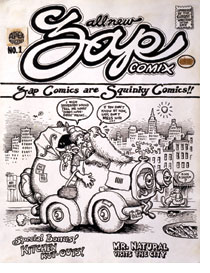 Robert Crumb Robert Crumb
Known as the father of underground “comix,” self-taught
illustrator Robert Crumb has produced thousands of
drawings and comic strips. Although greatly influenced
by classic comic strips from the 1930s, Crumb’s
content clearly reflects current society.
His work
in comics began in 1967 San Francisco, a hotbed
of social unrest and hippie counterculture,
with the
publication of Zap Comix #01. By taking a popular
cultural genre—comic strips—that previously
had been thought of as strictly for children, and
creating
work for adults that addressed social issues like
drugs, sex, race, and gender, Crumb inspired hundreds
of imitators
and acolytes. However, his work remains unique in
the genre of comics. His new form of comic strip
was dubbed “comix”—the
deliberate misspelling delineating its difference
from the typical kid’s comic book.
Many of
Crumb’s characters, such as “Mr.
Natural,” the hippie guru of “Keep on
Truckin’” fame,
became icons of anti-establishment pop culture, though
Crumb was never a hippie or a member of any subculture
or group himself. His later works include scathing
social satires on American culture and Americans,
themselves. 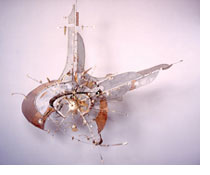 Lee
Bontecou Lee
Bontecou
Since the 1950s, Lee Bontecou’s art has
reflected both the beauty and cruelty of the
natural world and
the humans who inhabit it. From her 1950s sculptures
of welded steel with stretched canvas to her vacuum-formed
plastic fish of the 1970s to her work today, Bontecou’s
art has evolved while continuing to reflect her abiding
interest in nature, science, and technology.
She has
written, “Since my early years till now,
the natural world with all its visual wonders and horrors—man-made
devices with its mind-boggling engineering feats and
destructive abominations, the elusive human nature
and its multi-ramifications of the sublime to unbelievable
abhorrences—to me are all one. It is in the spirit
of those feelings that the primary influences on my
work have occurred.” 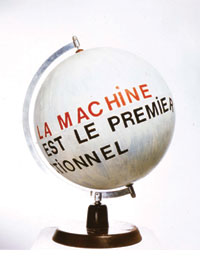 Mangelos Mangelos
Croatian
art historian and critic Dimitrije Basicevic´created
art under the pseudonym Mangelos, producing works that
focused on systems of expression such as thinking,
language, and even art.
Using text and calligraphy,
Mangelos expressed his philosophy by painting
manifestos on book pages, globes, school slates,
and exercise books in a palette of black, red,
white, and
occasionally gold. A product of post-war Yugoslavia,
Mangelos’ preoccupation
with overarching systems of control is not surprising.
The idea that technology has replaced human imagination
as the engine that drives the creation of art recurs
throughout his writings and his art objects, many
of which are tinged with satire.
In his 1977 “Moscow
manifesto” Mangelos wrote: “ART
IS DEAD and so is the old/naive way of thinking.
There are no/profound thoughts only
functional ones….art lost its social function with the advent of the
machine.”
Get
Wrapped Up in It Carnegie International
Programs
and Events
Every few years, the Carnegie International introduces
Pittsburgh audiences to some of the most exciting
contemporary art from around the
world. Get involved in the International by attending
performances, programs, and events that will bring
the exhibition to life for viewers of all ages
and backgrounds. Visit www.cmoa.org
for a complete schedule.
Opening Weekend Performances:
Oct. 9
1 p.m. – “Film” by Pawel Althamer – Actors
will perform 30 minutes of daily life, assuming
the roles of typical Pittsburgh passersby.
4 p.m. – Artist Katarzyna Kozyra – This
work is the culmination of a two-year-long project
in which the artist has made a serious attempt
to fulfill her lifelong wish to become an opera
singer.
Oct. 9 & 10:
Noon, 2, 3 p.m. – Artist Trisha Donnelly – Performed
daily in the Hall of Architecture, this five-minute
performance is a poetry reading
performed in costume.
Tours, Programs, and Events:
Daily Tours
Drop-in, docent-guided tours will take place daily,
Tuesdays through Sundays at 1:30 p.m. and on Saturdays
and Sundays again at 3 p.m.
Oct. 8: Opening Gala Party
7:30 p.m., $150 per person includes buffet dinner,
drinks, and entertainment
For reservations/information, call 412.578.2552
or email internationalgala@carnegiemuseums.org
Oct. 10: Members’ Opening Party
5-8 p.m., Free for museum members
For reservations/information, call 412.622.3314
or email membership@carnegiemuseums.org
Oct. 15: Curator Laura Hoptman
6 p.m., Carnegie Museum Lecture Hall
Join Curator of the 2004-5 Carnegie International Laura Hoptman for personal insights on some of
the art and artists in this 54th installation.
Oct. 21: Artist Julie Mehretu
5 p.m., Carnegie Mellon University,
McConomy Auditorium
Julie Mehretu’s paintings dance around the
history of both abstraction and representation.
Her unmistakable style and palette mine a confluence
of visual sources.
Oct. 28: Artist Senga Nengudi
5 p.m., Carnegie Mellon University,
McConomy Auditorium
An important figure in the African-American avant-garde
of the 1960s and 1970s, Senga Nengudi helped establish
a funk aesthetic that brought traditional African
forms into the mix of Western modernism.
Oct. 30: Artist Senga Nengudi with Filmmaker Linda
Goode Bryant
2 p.m., Carnegie Museum Lecture Hall
Delve deeper into the work and life of artist Senga
Nengudi through the eyes of nationally acclaimed
filmmaker Linda Goode Bryant.
ART in the Making
In the spirit of experimental architecture, interns
assist Lebbeus Woods with exhibition installation
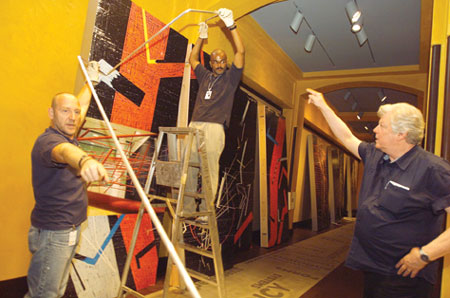
Photos: Tom Altany
It’s Friday, July 23, and six young men
and women are lifting and lugging a 24-foot-long,
aluminum colored table across an empty room in
the Heinz Architectural Center. There’s not
enough clearance at one end to walk around the
table,
which will hold architectural models. “Pivot
it here and swing it around,” says Lebbeus
Woods, whose exhibition they are helping to install.
Woods looks at his plan, looks back at the room,
and comments, “We’ve got a problem
here guys. It’s time to design on the spot.”
The
exhibition being installed is Lebbeus Woods:
Experimental Architecture. To help bring Woods’ vision
to life, a number of unpaid interns worked for
two weeks to serve as Woods’ hands. Kristen
Roddey, exhibitions associate, says, “The
interns’ work included bending 200 aluminum
tubes and stacking them to create The
Tangle and laying out large, interlocking panels of
aluminum
that create a pathway of words through the
exhibition.”
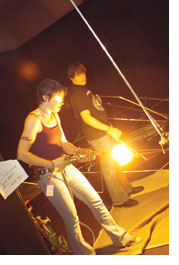 The
interns also assembled enormous images reproduced
from Woods’ drawings, each more than nine
feet high and as large as 21 feet wide. The
Tangle is a drawing in space made of bent aluminum tubes.
Working closely with Woods, the interns worked
with experienced workshop staff members, who
handled the more technical side of the installation
using
blowtorches, drills, and other tools of the trade. The
interns also assembled enormous images reproduced
from Woods’ drawings, each more than nine
feet high and as large as 21 feet wide. The
Tangle is a drawing in space made of bent aluminum tubes.
Working closely with Woods, the interns worked
with experienced workshop staff members, who
handled the more technical side of the installation
using
blowtorches, drills, and other tools of the trade.
Unlike typical fine art exhibitions, which are
entirely mounted by experienced art handlers,
this exhibition of enormous tilting prints
and dramatic
models of Woods’ experimental architecture
could be installed by anyone up to the task.
The three lead interns—Rachel Myers,
Doug Crain, and Ian Clemente—viewed this
exhibition as a great opportunity to gain hands-on
experience
working with a living artist.
Crain says he
joined the team because “this
particular show is more than an environment
housing Lebbeus Woods’ work; it’s
an environment created by his work.” The
interns especially enjoyed the fact that they
were part of the creative
process. Myers found the project appealing
because of the spontaneity. “We were
making art
as we went along,” she says. This concept
complements the experimental nature of Woods’ work,
according to Tracy Myers, Museum of Art curator
of architecture and the show’s
organizer. “He gave some of the information
and then allowed for a certain amount of chaos
and creativity,” explains Myers. “What
is unusual in this show is that many decisions
were made during the installation—all in
the spirit of experimental architecture. It’s
improvisational. It’s the difference between
working closely with the architect and asking
an architect to send us framed works to hang.”
West Meets East: Asian Influences on European
Decorative Arts
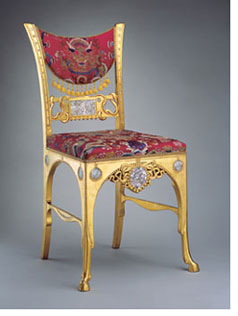 Side
chair, c. 1882 Side
chair, c. 1882
Christian Herter, Designer; Herter Brothers, Maker (American); gilded maple,
mother-of-pearl inlay and embroidered silk, Dupuy Fund.
In the 17th and 18th centuries, trade routes opened
the once mysterious Far East to European traders.
Only the wealthiest westerners could afford to
purchase the rare and exotic decorative objects
that began to trickle out of China and other
Asian countries. Soon, European interiors and decorative
arts began to show signs of Asian influence.
By
the 19th century, when Japan opened its once
guarded borders to foreigners, “Japan mania” ensued,
particularly in America. On Monday, October 25,
two leading experts on Asian-influenced decorative
arts will speak at the 27th Annual Women’s
Committee Decorative Arts Symposium. Danielle Groshëide,
associate curator of European sculpture and decorative
arts at the Metropolitan Museum of Art, will speak
about the importance and role of lacquer in the
17th and 18th centuries. Writer and lecturer Cheryl
Robertson will address the Japanese mania that
took America by storm after the Civil War, and
later influenced both the Art Nouveau and Arts
and Crafts Movements.
For more information and
reservations, please call Jenny Treganowan at
412.578.2624.
Back to Contents |